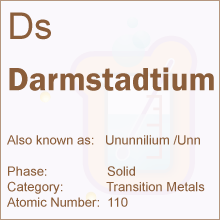 Periodic Table -> Darmstadtium
Periodic Table -> DarmstadtiumDarmstadtium
Darmstadtium DetailsDarmstadtium Symbol: Ds
Darmstadtium Atomic Number: 110
Darmstadtium Atomic Weight: (281.16)
What is Darmstadtium?
Darmstadtium (atomic number 110, symbol Ds) is a synthetic element first produced at the GSI Helmholtz Centre for Heavy Ion Research in 1994. Temporary name was Ununnilium.
Chemical and Physical Properties and Radioisotopes
The properties of Darmstadtium are only partially known to scientists. Its chemical and physical properties have not been sufficiently studied because the element has never been synthesized in pure form. Element 110 has an atomic weight of 281. It is predicted to be at solid state at room temperature, with a body-centered cubic structure. Its density is 34.8 grams per cubic centimeter, which makes it a heavy metal. The high density can be explained with the element’s high atomic weight. It’s boiling and melting points are unknown to date and so is its ionization energy. Scientists predict 5 oxidation states – 0, 8, 2, 4, and 6. The ionic and Vanderwaals radius are also unknown. Some of its isotopes have been artificially produced in research settings, all of them being radioactive. The element has 8 isotopes, among which Ds-277, Ds-273, Ds-271, and Ds-269. Isotopes such as Ds-277 and Ds-286 can be synthesized through the reaction of Ca-48 and Th-232. Some of the isotopes undergo spontaneous decay while others decay through alpha decay. The heaviest and most stable isotope is Ds-281 which has a half life of 11 seconds. This is a metastable isotope which decays through alpha decay and spontaneous fission. None of the element’s isotopes are stable, and only small amounts have been synthesized in research settings. It is expected that Darmstadtium shares properties with platinum, palladium, and nickel. They have high boiling and melting points and are refractory, hard, highly ductile, and silvery-white in color. This is a highly radioactive element which belongs to the group 10 elements. Darmstadtium is heavier than other d-block elements and is considered a noble metal.

The element was discovered by the German physicists Gottfried Münzenberg and Peter Armbruster. The team was led by Sigurd Hofmann, a German physicist who made significant contributions to the discovery of elements such as meitnerium, hassium, bohrium, copernicium, and roentgenium. They used Ni-62 to bombard Pb-62, and a single atom of Ds-269 was produced. The team used a lead target and over a billion of Ni ions. At first, the scientists synthesized atoms with a half life of 1/10th of a second and then succeed in synthesizing heavier atoms with longer half lives. Darmstadtium is named after the city of Darmstadt, and the name was also recommended by IUPAC and confirmed in 2003.
Uses, Applications, and Role
Lead and nickel atoms are fused in a heavy iron accelerator to produce Darmstadtium. The element has no known uses because its properties are yet to be studied. It is only used in experimental chemistry. Only a few atoms have been synthesized. The metal has no known biological role and does not occur free in nature. It has no effect on the environment because of its short half life. Samples decay quickly in lab settings.
You can
link to this page, using the code below:
Periodic Table |
Banks
© ElementsDatabase.com 2015 | Privacy | About | Contact